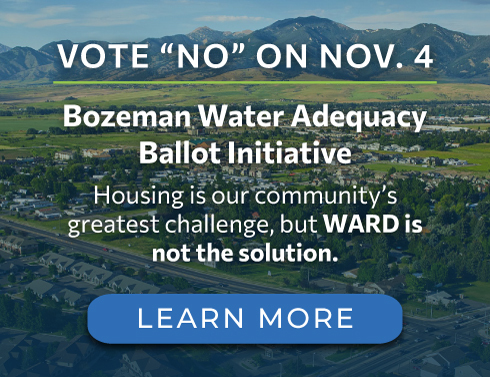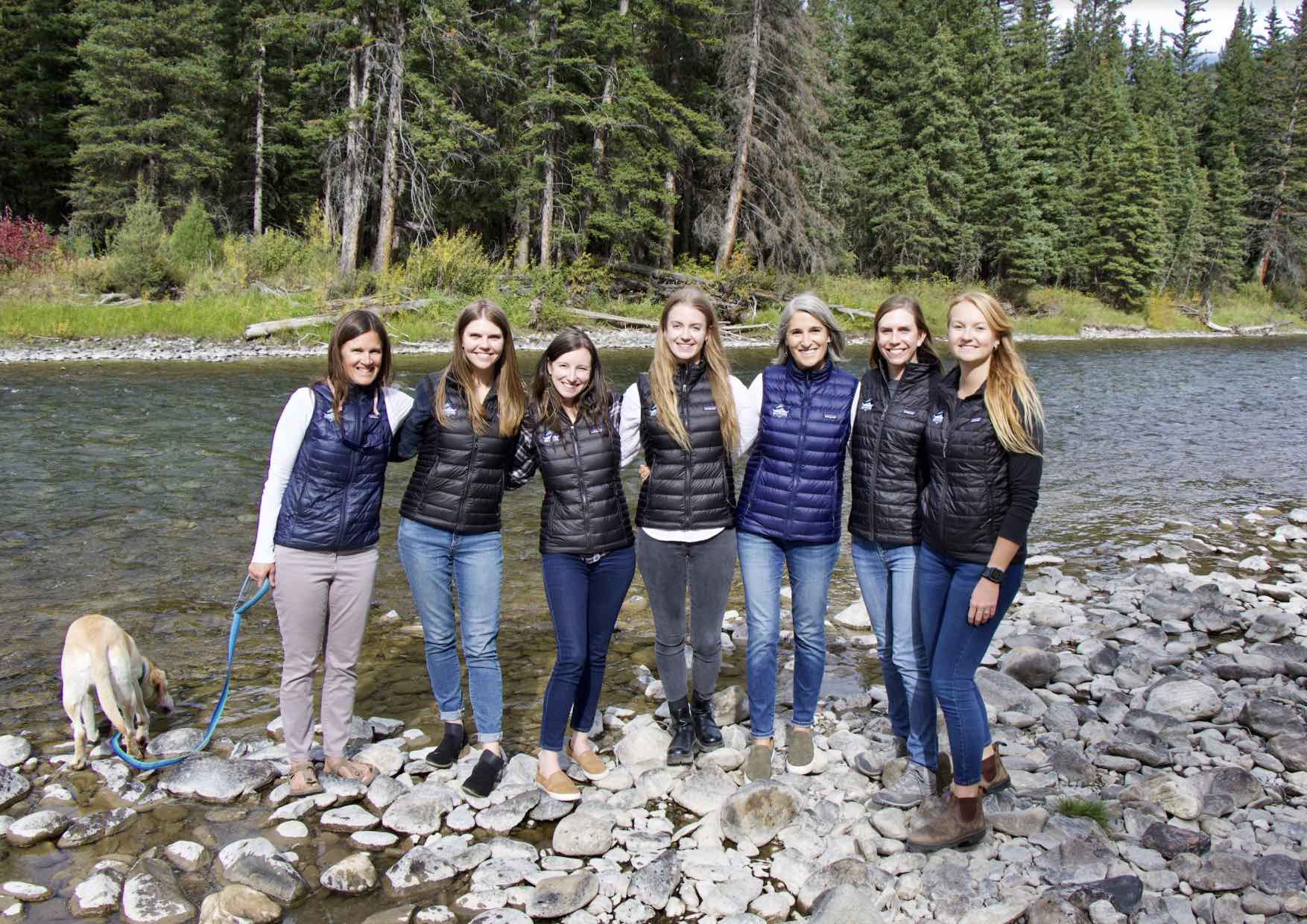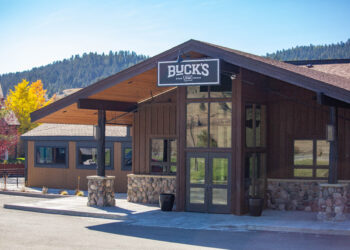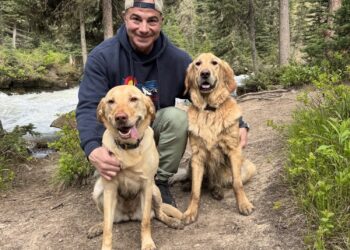By Mira Brody CONTENT PRODUCTION DIRECTOR
BIG SKY—If there’s one thing that all Gallatin River Task Force employees, board and volunteers have in common it’s their love for the Gallatin River. Here in Big Sky, water is life—from our drinking water, recreation activities and also our economy. The Task Force, a grassroots effort founded in 2005, works to protect that life. For this Making it in Big Sky, Explore Big Sky sat down with Kristin Gardner, the nonprofit’s chief executive and science officer, and talked about the Task Force’s conservation projects and how you can get involved. Whether you’re volunteering, donating or simply doing your best to conserve and protect our watershed, those who invest in the Task Force’s mission are key to its success.
This series is part of a paid partnership with the Big Sky Chamber of Commerce. The following answers have been edited for brevity.
Explore Big Sky: First, let’s start with a little background on you—when did you first come to Big Sky; what brought you here?
Kristin Gardner: I first started coming to Big Sky regularly in 2003 as a graduate student at Montana State University (MS) to collect field data for my doctoral research that examined the impacts of land use change on streamwater nitrogen patterns. Then in 2005, I received a National Science Foundation scholarship that places scientists in the classroom to assist teachers in developing science curriculum and to hone skills in communicating science to non-technical audiences. I moved to Big Sky full time in 2006.
EBS: How did you get involved with the Gallatin River Task Force?
KG: My first connection with the Task Force was as a volunteer collecting water quality data when the organization was based out of MSU. Shortly thereafter, I connected with Katie Alvin, the founding executive director of the Big Sky based nonprofit, to obtain landowner contacts to access sampling locations. In addition, she helped me recruit local volunteers to collect water data for large sample collection days when we would go out and collect 50 samples across the watershed in one day.
EBS: Tell me about how GRTF came to be: Who were some of the initial founders and what sparked the idea?
KG: The Task Force started as a grassroots effort organized by the Montana Water Center at MSU to collect water data in the Gallatin River. The Big Sky Water and Sewer District had obtained a permit to discharge treated wastewater effluent into the Gallatin River. The purpose of the data collection was to collect baseline data prior to a surface water discharge to assess whether or not the discharge had an impact on the water quality of the Gallatin River. The BSWSD never used the discharge permit and let it expire and consequently, we are a 100% wastewater reuse community. In 2005, a group of dedicated volunteers led by Katie Alvin and Jon Holtzman, decided to formalize the grassroots effort into a nonprofit 50(c)(3) organization and move the headquarters to Big Sky.
EBS: Tell me about your staff and board—how many people are behind the work that GRTF does?
KG: We have a talented dedicated staff team of five and board team of 12 that have one thing in common—their passion for the Gallatin River. In addition, we regularly host two AmeriCorps members and typically recruit a few interns in the summer. We rely heavily on support from over a hundred and fifty volunteers and dozens of partner organizations and landowners to move our project work forward.
EBS: What are some of the largest threats to the Gallatin River right now? Have those threats changed at all over the years?
KG: The abundant love of and demand for recreation and development along the Gallatin River between Yellowstone National Park and Bozeman has placed serious pressures on our local rivers, streams, and groundwater. Temperatures are rising and winter snowfall patterns are changing. Collectively, these shifts present an unsustainable proposition for water if left unchecked. Big Sky’s unique geographic management structure is complex, with public and private lands, two county jurisdictions and multiple district-based administrative bodies. This creates an urgent and ongoing need for trust-based collaboration, a focus on community education and behavior change, and the invaluable application of science-based decision making to protect our water resources.
More specifically, the largest threats I see are poorly treated wastewater, water used for landscaping, and the fragmented government structure that exists to manage water in our community. Water is a public resource and deserves a more holistic approach. Over the years the threats have increased with increasing people, but we have also made significant progress to address these threats. However, there is still much work to be done.
EBS: Why is a healthy river so important, and why the Gallatin specifically? Does our local river health in turn affect other connecting waterways?
KG: In Big Sky–Water is life. The plentiful snow of winter on Lone Peak, the healthy trout habitat, and the abundant wildlife and history of indigenous peoples have all, over generations, been supported by the Gallatin River and its waters. These same treasured waters have inevitably become an economic engine for the region—an asset in driving tourism and development, in turn creating jobs and opportunity for many businesses and individuals. Water flows downstream so our local river health both water quality and water quantity affects downstream waters.
EBS: How can the community help? What sort of support or work makes the largest waves when it comes to river conservation and the work GRTF does?
KG: We have a small staff team so community help is critical to protect our waters in and around Big Sky—Everyone has a role to play. Examples of individual actions include:
- Get educated and engaged
- Convert lawns to native landscapes
- Upgrade and maintain septic systems or connect to central sewer
- Use water saving fixture devices (check out EPA Watersense)
- Vote for representatives that support clean water initiatives and regulations
- Call Senator Daines and ask that he support the Montana Headwaters Legacy Act,
- Volunteer with the Task Force
- Attend community events
- Advocate for more protective regulations at local, state and federal levels
- Join a local board or attend board meetings in organizations that make water decisions (Task Force, Gallatin Canyon/Big Sky zoning committee, Resort Tax, Water and Sewer)
EBS: Is there any business advice you’ve received over the years you feel has made an impact on your work?
KG: Think big and outside the box, and take calculated risks to open the doors to change, progression and success!
EBS: Anything else you’d like to tell the Big Sky community?
KG: Protecting our rivers and drinking water is going to take a collective community effort that will include sacrifice. We may not be there yet, but at some point in our future, we will have to make a decision on whether we want green lawns and golf courses or a healthy river with thriving trout populations. I hope we choose the latter.
Gallatin River Task Force current projects
Since 2000, the Task Force has prioritized water-quality monitoring as the foundation of their work in protecting the Gallatin River, which falls under three categories: reducing nutrient pollution to address algae blooms, protecting our water supply and reducing river recreation impacts.
- Upgrading wastewater treatment in Gallatin Canyon by replacing septic systems with centralized wastewater treatment, reducing harmful levels of nutrient loads by 70%.
- Installing two wetland treatment systems that will reduce harmful level of nitrogen flowing into the West Fork of the Gallatin by 2,000 pounds per year.
- Establishing a new benchmark nitrogen level that is sustainable for the health of the Gallatin through monitoring efforts with the Montana Department of Environmental Quality.
- Convening community water providers to coordinate and assist in groundwater monitoring and water conservation efforts.
- Advocating for wastewater recycling that benefits the water system supplying water for drinking and for the Gallatin.
- Executing restoration projects on the Middle Fork, South Fork and West Fork that reduce pollutants, improve water quality and allows for more water in the rivers and our drinking water aquifers during hot, dry summers.
- Repair streambanks, improve fish passage, and enhance riparian vegetation and floodplain connection at the Porcupine/Beaver Creek access site.
- Restoring up to 20 river access parking areas along the mainstem Gallatin.
- Reduce erosion and direct and improve river access near the confluence with Portal Creek, Doe Creek, Greek Creek and Lava Lake.
- Reduce consumptive water use in Big Sky by 20%.
- Continue to advocate for Wild and Scenic designation for 39 miles of the Upper Gallatin and 17 miles of the Taylor Fork.
Learn more at gallatinrivertaskforce.org.














